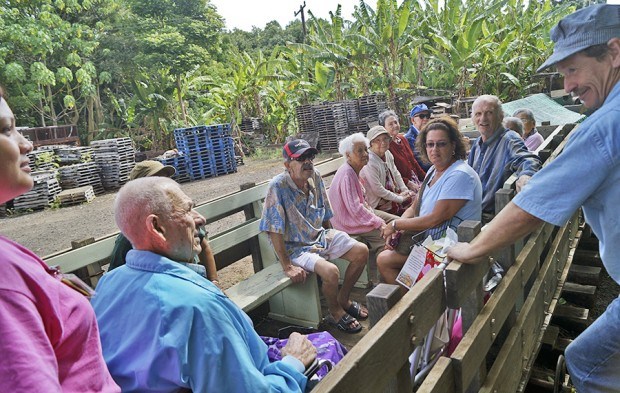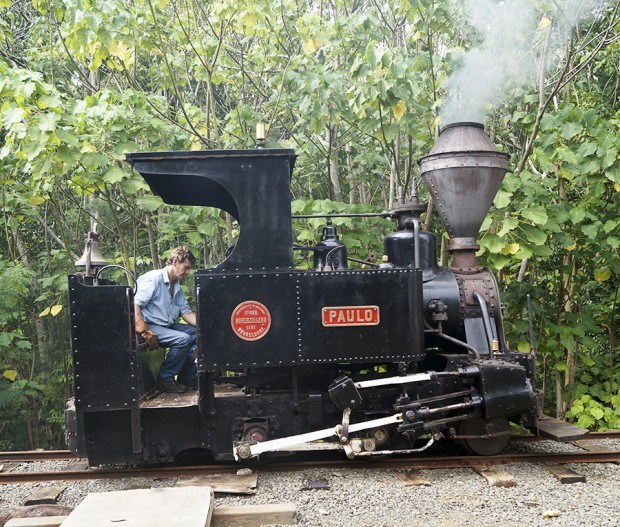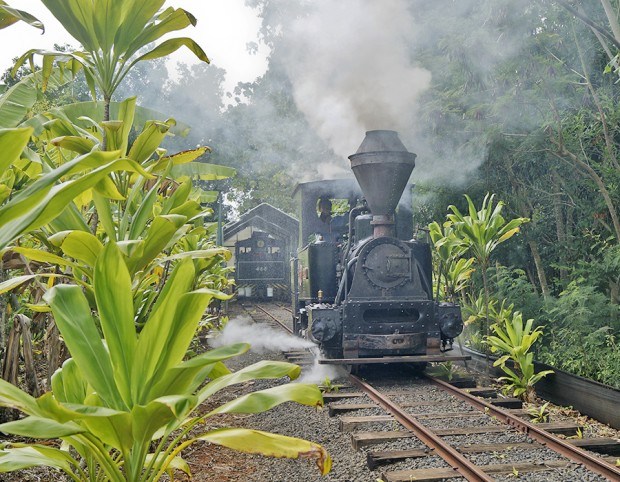LIHU‘E — Manny Corregedore said he’s lived just down the street and has never had a ride aboard Paulo, one of the last remaining operating steam locomotives. Corregedore joined a group from the Hale Kupuna Heritage Home in Oma‘o who
LIHU‘E — Manny Corregedore said he’s lived just down the street and has never had a ride aboard Paulo, one of the last remaining operating steam locomotives.
Corregedore joined a group from the Hale Kupuna Heritage Home in Oma‘o who had seven of its residents and three staff take a ride aboard the historic steam locomotive, Friday.
“As long as I know there are people, we keep the locomotive heated,” said Scott Johnson, the Grove Farm Museum engineer. “We had our monthly fire up day, Thursday and the seniors came Friday. We will also be running on Sept. 29, the Smithsonian magazine’s National Museum Day.”
Johnson said September is a very special month because on Sept. 24, 1881, Liliu‘okalani whacked in the first spike marking the start of railroading on Kaua‘i.
“She did it in just two whacks,” Johnson told the kupuna who were excited to be able to ride the historic locomotive.
On Sept. 24, 1957, Hawai‘i’s last steam sugar cane train, this time Wainiha, Paulo’s sister locomotive at the Grove Farm Museum, pulled the final load on the tracks at the Haleko facility to the Lihu‘e Sugar Mill, Elisio Antonio, Grove Farm’s last engineer and Hawai‘i’s last steam cane train engineer, at the throttle.
The Grove Farm Museum operates its “Fire up” day on the second Thursday of each month with people being able to make reservations by calling 245-3202.
“This month is special because on Sept. 29, we celebrate the Smithsonian Magazine day and we’ll have train rides from 10 a.m. to 3 p.m.,” Johnson said. “The Grove Farm Museum on Nawiliwili Road will also be open so people have an opportunity to visit.
The Smithsonian magazine’s National Museum Day is an annual event hosted by museums across the country, states the Kaua‘i Trains website.
Joining Corregedore on the tour, Albert Souza, was excited about being able to ride the train, said Pacita McDermott, the Hale Kupuna Activities Director.
“This smells really good,” said Kristen Ortal-Freitas, Hale Kupuna Activities Associate, who grew up in Kaumakani. “It reminds me of the old days when hot water needed to be heated by fire. It’s a good smell.”
Johnson said Paulo, along withWainiha, are both steam-driven, the water being heated by firewood — discarded wooden pallets as well as logs from invasive trees growing on the property.
“We take the trash, burn it to power the locomotives and the remaining ash makes one of the best additives for acid soil like the type we have in Hawai‘i,” Johnson said. “Additionally, the oil we use costs more, but is biodegradable which means, in 10 days, anything which leaks will be no more.”
Paulo, which operated during the Fire up day, is the oldest surviving operating plantation locomotive in Hawai‘i, states the Kaua‘i Trains website. It was manufactured in Dusseldorf, Germany in 1887 at the Hohenzollern Works and shipped to the Koloa Sugar Co., the first commercial sugar plantation in the kingdom of Hawai‘i, where it was used until 1920.
Named for Paul Isenberg, the owner of Lihu‘e Plantation and an officer with the Koloa Sugar Co., Paulo weighs in at 10 tons and could pull more than that weight. Paulo, just coming back following work on its tubes, was restored in 1980.
Visit www.kauaitrains.com for more information.
• Dennis Fujimoto, photographer and staff writer, can be reached at 245-3681 (ext. 253) or dfujimoto@ thegardenisland.com.




